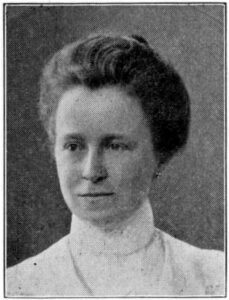 Jacoba van Heemskerck van Beest in 1913.
Jacoba van Heemskerck van Beest in 1913.
Photographer unknown.
With her colourful paintings, strong woodcuts and transparant stained glass artworks, Jacoba van Heemskerck has made a great impact on Dutch modernism. In her days, she was one of the most frequently exhibited artists, both in The Netherlands and abroad.
Life and work
Jacoba Berendina van Heemskerck van Beest was born on 1st April 1876 in Den Haag (The Hague). She was the youngest of six children; her father was an officer in the Royal Dutch Navy and also a painter of seascapes. Her father taught he the basic ins and outs of painting.
When her mother died in 1901 – she was 25 then – she moved to Hilversum, a town not far from Laren. She realised that she would have to face life and work allone.
She went to Paris to study in the classes of symbolist Eugène Carrière, who in 1898 had founded his own art school that accepted women. Paris, then the embodiment of progress and modernism, offered her new methods like pointillism and luminism. For three years she commuted between Hilversum and Paris and in 1904 she participated in an exhibition at the Salon d’Automme, produces by the Union des Femmes Peintres & Sculpteurs.
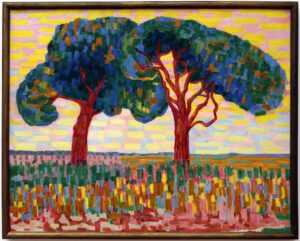
In August 1905 she moved back to The Hague, to be closer to her friend and art collector Marie Tak van Poortvliet. From then on she often participated in exhibitions organised by the artists’s association St. Lucas and the Stedelijk Museum in Amsterdam. Marie Tak van Poortvliet had become rich after the death of her parents and had a house built in Domburg, an artist’s village in the Southern province of Zeeland. The house was called ‘Loverendale’ and contained a studio for Jacoba van Heemskerck. Both women spent their summers in this house in Domburg, where lively exchanges took place with artists like Jan Toorop and Piet Mondriaan. In her search for personal expression she developed her style from pointilism to cubism.
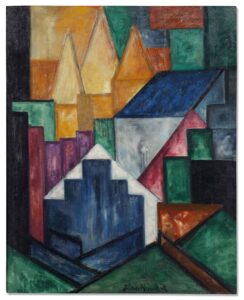
In 1913, during an exhibition in Berlin, she met Herwarth Walden who ran the avant garde movement & magazine ‘Der Sturm‘ in Berlin, together with his wife Nell. They became good friends and from then on Jacoba made many wood carvings for the magazine. She remained connected to them and Der Sturm for some years. Der Sturm stood out from other art magazines of that time for including the art created by women. The exhibitions organized by the magazine included works of Gabriele Münter, Sonia Delaunay, Else Lasker-Schüler, Marianne von Werefkin, Natalia Goncharova, Jacoba van Heemskerck and others. In 1914 she gives Walden the exclusive rights to exhibit and sell her work, and she starts numbering her art instead of giving it a title. But after 1918 she worried about the possible loss of quality of Der Sturm, but her friendship with the Waldens remained although she distances herself from Der Sturm around 1920.
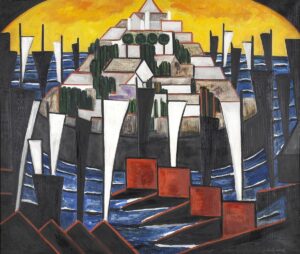
Around 1915, both Jacoba van Heemskerck and Marie Tak van Poortvliet became followers of the Theosophical, later Anthroposophical (Rudolph Steiner) society. From then on she aimed to express not so much her feelings about a certain subject, but the “spiritual truth” about it, as she called it herself, as she explored the ‘spiritual meaning of colour’.
Medical student (later psychiatrist) Willem Zeylmans van Emmichoven and Jacoba van Heemskerck met at an exhibition and became friends. His interest in colour was inspired by Jacoba and her friend and patron Marie Tak van Poortvliet; it led him to research the effects of colours on the life of feelings. In 1918, together with Zeylmans she performs empirical experiments on the emotional impact of colours.
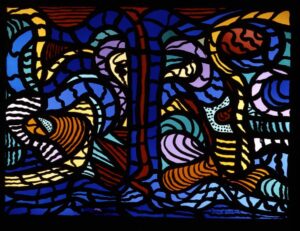
During the same period, she created her first studies for works in stained glass, an idea she had already explored in 1914. She received quite a few commissions for stained glass windows, e.g. for the villa Wulffraat in Wassenaar in 1920, for the Marine Base in Amsterdam in 1921. She organised exhibitions in The Netherlands and her works, including those in stained glass were received with great enthousiasm.
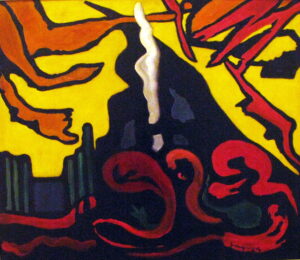
She distanced herself somewhat from the Dutch modernists and expressionists because of her statement: “They write more than they paint.” She found them to be too theoretic. Her own focus had shifted from observation of reality to the spiritual meaning – undoubtedly under the influence of Steiner and Zeylmans van Emmichoven.
In the last years of her life she was seriously ill with angina pectoris. Jacoba van Heemskerck van Beest died on 3rd August 1923 in Domburg, most probably from myocardial infarction (heart attack). She was only 47.
Her friend and patron Marie Tak van Poortvliet left a large part of her Van Heemskerck collection to the Kunstmuseum in The Hague, which now owns the largest collection of her works. Other works can be found at Boymans van Beuningen Museum in Rotterdam, The Kunstmuseum in Bern, the Berlinische galerie, the Landskrona museum in Malmö and at the Marie Tak van Poortvliet Museum in Domburg.
Professional education
1897-1901 Royal Academy of Visual Arts in The Hague.
From 1900 she took weekly lessons from Ferdinand Hart Nibbrig in Laren, an artist’s village.
From 1906 Van Heemskerck and painters like Piet Mondriaan and Jan Toorop influenced each other.
Exhibitions (selection)
1904 – Salon in Paris.
From 1906 – regular exhibitions in Domburg, Zeeland.
From 1911 – annual exhibition Moderne Kunstkring Amsterdam, Jan Toorop’s pavillion Domburg,
and at the Salon des Indépendents in Paris.
1913 – Erster Deutscher Herbst Salon in Berlin.
1914 – first exhibition for Der Sturm. Many more followed.
Until her death in 1923, many (inter)national exhibitions, a.o. in Amsterdam, Domburg, Berlin, Düsselforf, Antwerp, Göteborg, Copenhagen.
After 1923 – many posthumous solo-exhibitions in The Hague, Amsterdam, Amersfoort, Bonn & Berlin.
Sources
– Catalogue 2021. Jacoba van Heemskerck. Truely Modern. Hirmer, Germany.
– Duppen, F. van. 2022. Jacoba van Heemskerck, in Vrouwenpalet 1900-1950. Zwolle, uitg. Waanders.
– Groot, M. 2007. Vrouwen in de vormgeving in Nederland 1880-1940. Rotterdam: 010 Publishers.
– Hussen, A. et al., 2005. Jacoba van Heemskerck van Beest 1876-1923. Zwolle: Waanders.
– Jacobs, P.M.J.E. 2000. Beeldend Benelux. Tilburg: Studiecentrum Beeldende Kunst.
– RKD, Den Haag
– Wikipedia